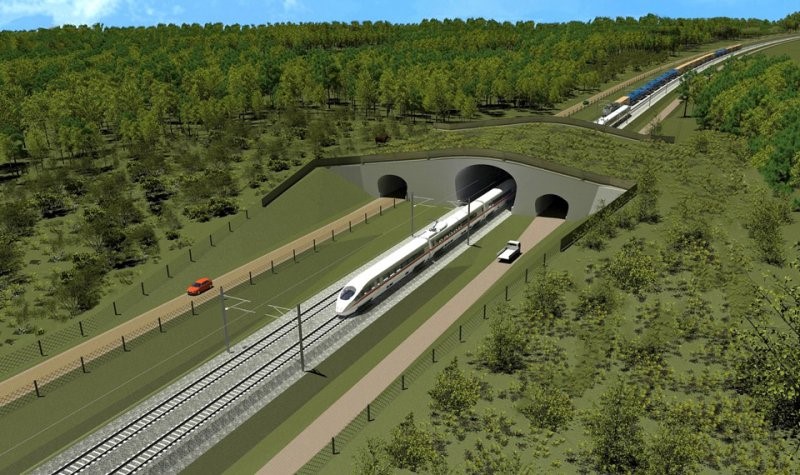Rahvusvahelise ühendusega kiirraudtee Rail Baltic Eestis
Rail Baltic on rahvusvaheline raudteeühendus, mille visioon ühendamaks Eestis, Lätit ja Leedut ülejäänud Euroopaga on pärit juba 1990ndate algusest [4]. Tänaseks on kindlaks tehtud marsruut suunaga Tallinn–Pärnu–Riia–Panevėžys–Kaunas, edasi Varssavisse saamiseks on olemas vajalik raudteeühendus ümberistumisega. Uus raudtee saab olema kogu pikkusega ~870 km ning reisirongi kiiruseks kuni 240km/h [7].
Rail Balticust räägitakse kui keskkonnasäästlikust reisi- ja kaubaveo võimalusest Kesk- ja Lääne-Euroopasse ning Põhjariikidesse. Projektis elluviimisel peetakse silmas rangeid ohutusnõudeid, turvaliseks rongiliikluse juhtimiseks kasutatakse kaasaegset Euroopa raudteeliikluse juhtimissüsteemi (ERTMS). Uue kiirraudtee kogumaksumus ulatub 5 miljardi euroni, mille rahastajad on Eesti, Läti, Leedu ning ka EL [6]. Antud projektiga kahjustatakse enim looduskeskkonda ning rahulikes paikades elavate kogukondade gruppe, sh kahjud ka metsaomanikele ja põllumajandusega tegelevatele inimestele, kelle maadest kiirraudtee läbi hakkab kulgema [2]. Eesti näitel on 66 meetri laiuses trassikoridoris ja 210 km pikkusel raudteel 850 ha metsamaad, millest 300 ha kuulub eraomandisse [3]. Maa omandamisega püütakse leida igat Rail Balticuga seotud osapooli rahuldav kokkulepe, selle mitte saavutamisel rakendatakse aga sundvõõrandamine [6]. Suurim negatiivne mõju leiab aset Rail Balticu ehitusjärgus, kui raudtee luuakse paikadesse, kus varem pole ühtegi trassi olnud. Sellega hävitatakse loomade, taimede, inimeste elupaiku ning veeringlust, samuti loomade ja lindude harjumuspäraseid rändeteid [5]. Rändeteede olukorra leevendamiseks plaanitakse rajada mitmeid suurulukitele mõeldud ökodukte, erilahendusega sildasid ning väiksematele loomadele ka eraldi läbipääse, samuti pole veel raudtee täpne asukoht kindel, mispärast ei saa ennustada paljude elupaikade killustumist [1]. Briti uuringufirma AECOM-i poolt kinnitati, et raudtee on otstarbekam rajada Euroopa standardrööpmelaiusega (1435mm), mis tagaks ka vaiksema rongiliikluse [4]. Praeguse hetkega on arvestatud 32 rongi möödumisega ööpäevas [1]. Sellest tulenevalt ei ole võimalik täielikult vältida tekkivat mürareostust ja vibratsioone, mis senise rahuliku eluviisiga elusolendeid häirima hakkaks [5]. Projekt on saanud palju negatiivset kui ka positiivset vastukaja. On korraldatud erinevaid protestiaktsioone ning kogutud allkirju, seda nii maaomanike kui umbusklike kodanike poolt, et takistada projekti elluviimist. Hetkeseisuga toimuvad läbirääkimised maaomanikega, koostatakse detailplaneeringuid, viiakse läbi vajalikke uuringuid jne. 2019. a. on plaanis alustada ehitustöödega põhitrassil ning alates 2026. aastast soovitakse avada liiklus Rail Baltic raudteel [6].
Environmental impact
- Air pollution
- Land degradation (e.g. drought, soil contamination, erosion and desertification)
- Biodiversity loss – Ecosystem destruction
- Waste, waste disposal, and toxicants
- Alteration of landscape aesthetics and built heritage
Ethical/ legal issues
- Health and well-being
- A clean and prosperous environment and a safe and pleasant habitat
- Indigenous land, culture and rituals
- Access to public goods/ resources and products
Information sources & materials
Online books and newspaper, magazine, encyclopedia, or blog articles
[1]. Heiki Kalle: What does Rail Baltica mean for the environment (2016). URL: http://railbaltic.info/et/10-ee-sisu/433-heikki-kalle-mida-taehendab-rail-baltic-keskkonnale (16.08.2017)
[2]. Metssalu, J. (2014). Environmental Impact Assessment. Openly about Rail Baltica. URL: http://avalikultrailbalticust.ee/index.php?id=6 (15.08.2017)
[3]. Mets, M. (2017). Rail Baltic nörritab metsaomanikke. Äripäev. URL: http://www.aripaev.ee/uudised/2017/03/21/rail-baltic-metsaomanikke-ei-hellita (15.08.2017)
[4]. National Audit Office’s overview of the agreement between the governments of Estonia, Lithuania and Latvia regarding the development of the Rail Baltica railway connection (2017). URL: http://objektiiv.ee/wp-content/uploads/2017/05/RKTR_2425_2-1.4_2177_004-2.pdf (15.08.2017)
[5]. Openly about Rail Baltica (2014). Problems. URL: http://avalikultrailbalticust.ee/index.php?id=37 (15.08.2017)
[6]. The Rail Baltic Project (2015). URL: http://railbaltic.info/et/projektist-rail-baltic (15.08.2017)
Legal & public policy reports and documents
[7]. Rail Baltica Global Project Cost-Benefit Analysis (2017). Final Report. URL: https://www.dropbox.com/s/f7om2698sxmbxyn/RB_CBA_FINAL_REPORT.pdf?dl=0&oref=e (15.08.2017)
Contributor(s)
Pille-Riin Meltsas, pilleriin.meltsas@hotmail.com , MSc student of Estonian University of Life Sciences



Home › Forums › Rail Baltic high-speed railway project in Estonia